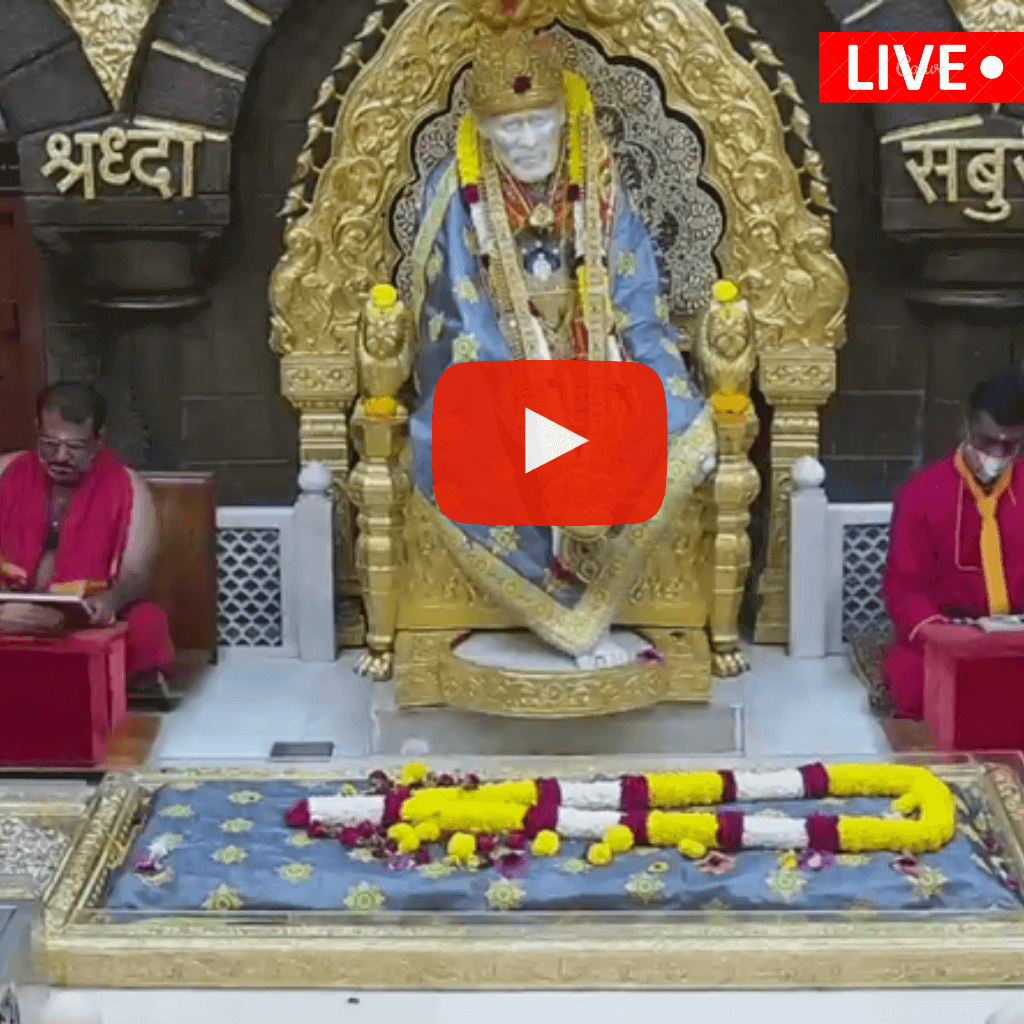Sai Baba Live Darshan
Sai Baba Live Darshan is broadcasted by Shirdi Sai Baba Sansthan between 4am-11pm (Indian standard time) everyday. The broadcast covers all the activities live happeing in the temple everyday. The Shirdi Sai Baba Sansthan has all rights reserved of the live broadcast.
Shri Sai Baba Live Darshan Shirdi Schedule :
| Time | Event |
|---|---|
| 4 AM | Temple Opens |
| 4:15 AM | Bhupali Aarti |
| 4:30 AM | Kakad Aarti |
| 5:00 AM | Bhajan |
| 5:05 AM | Mangal Snaan |
| 5:35 AM | Shirdi Majhe Pandharpur |
| 5:40 AM | Temple Opens for Darshan |
| 11:30 AM | Prasadam Offering to Shri Sai Baba |
| 12:00 PM | Madhyam Aarti |
| 4:00 PM | Sai Satcharitra Reading |
| Sunset | Dhoop Aarti |
| 8:30 PM | Devotional Songs |
| 10:30 PM | Shej Aarti |
P.S : Shirdi Sai Baba Sansthan holds all rights of live telecast.
Devotees Avid Affection for Sai Baba Darshan :
According to Shirdi Sansthan, on an average 25000 people visit temple daily for Baba’s darshan and on festive seasons more than 100000 (one lakh) devotees flock to the temple everyday. Everyday devotees queue up to seek Shri Sai Baba’s Darshan. Devotess carry flowers,garlands, shawls,Sai Baba books etc to offer to the holy feet of Baba. People chant “Sai-Sai” in the queues while taking darshan. People also wait hours in the line during the festive session to pay tribute the lord.
History of the Samadhi Mandir:
The Samadhi Mandir which was known earlier as Wada was built on the same place where Baba grew the flower garden. In the ealy days he used to carry pitchers of water and watered the plants of Jai and Jui and Marry Gold which he bought from a nearby village called as Rahata. The inspiration of building the Wada came to Bapusaheb Booty, a great devotee of Sai Baba. Bapusaheb Booty is mentioned as a millionaire in the Sai Satcharitra. Baba appeared in Booty’s vision when he was sleeping with Shama, he adviced him to build a temple and a house. immediately after the vision they drew sketches of the building showed it to Baba for approvals. Baba granted blessings for the project.
The work began around the year 1915,when Baba used to pass the site on his way he used to say “When the temple is ready we shall inhabit it”. No one knew what Baba meant by this words. In the year 1918 Baba felt significantly ill and all the devotess were worried about Baba’s health. Booty and other close devotes of Baba were worried if baba could see the completed Wada. On 15th October 1918 Baba left his body saying “I am not feeling well in the Masjid,take me to the Wada”. Sai Baba was carried to the Wada and buried there,whis is now known as the Shri Sai Baba Samadhi Mandir. A photograph of Sai Baba was placed on the the platform and later in 1954 statue of Shri Sai was installed.
Mahasamadhi
15th October 1918 Baba took Mahasamadhi at around 2:35 in the afternoon. This day was a hindi festval Dusshera also happened to be Muslim’s festival Moharram. Thus signifying that all the castes,religions are manmade barriers. Baba’s heath was deteriorating day by day. He stopped his begging rounds three days before the Mahasamdhi. At around 2:35pm he left his body after the afternoon aarti. The news spread like wild fire and people rushed to the Masjid to take Sai Baba’s Darshan.
There were disputes among people about where the body should be interred. Some mohammedans suggested,his body should be inteered in open space. But the villagers were against this suggestion. This discussion went for about 36 hours. t the end all the disputes were settled and paying respect to Baba’s words people decided to interr the body in Wada. The burial was completed by Thursday morning and Baba was finally interred in the central portion in the Booty Wada.
Also Read : Sai Baba’s 11 Principles | Sai Baba’s Teachings
Kakad Aarti Shri Sai Baba Samadhi Mandir, Shirdi :
Madhyan Aarti Shri Sai Baba Samadhi Mandir, Shirdi :
Dhoop Aarti Shri Sai Baba Samadhi Mandir, Shirdi :
Shej Aarti Shri Sai Baba Samadhi Mandir, Shirdi :
Commencement of Aarti and Pooja to Shri Sai Baba
In the earlier days, devotees only offered garlands of flowers to Baba. In 1900 Mahadeo Chandorkar son to Nanasaheb Chandorkar started performing Pooja of Shri Sai. Mahadeo Chandorkar alias Bapurao has the sole rights of performing Pooja.
The practice of Aarti commenced on Guru Purnima day and later continued. Devotees used to apply Sandal paste to Baba’s forehead and worship him. In the beginning, there were only a few Aartis composed on Baba by Adkar and Das Ganu.
Tyata Noolkar regularly worshipped Baba by Aartis composed by Adkar. Later Megha continued performing baba’s Aarti. After Megha, it was Bapusaheb who continued performing Baba’s Aartis till Sai Baba’s Mahasamadhi.
J. Bhisma a resident in a nearby village arrived in Shirdi. When we visited Masjid to take Darshan of Baba. Baba asked him to give five ladoos. Bhisma was not able to recollect by what Baba meant by five ladoos.
The next day he got up with a strong urge to compose poems. He composed five poems which he offered to Baba. Baba happily blessed him. Later he wrote 4 more poems. Then he prepared a booklet of all Aartis composed and sung in front of Baba.
The booklet was named –“Shri Sainath Sagunopasana”. After Baba’s Mahasamadhi this book was referred to as a daily book of worship in the Shri Sai Baba Samadhi Mandir. Later revised edition of Shri Sainath Sagunopasana was published in 1923.
Personality of Sai Baba :
It is on account of Sai Baba that Shirdi grew into importance. Let us see what sort of a personage Sai Baba was. He conquered this Samsar (worldly existence), which is very difficult and hard to cross. Peace or mental calm was His ornament, and He was the repository of wisdom. He was the home of Vaishnava devotees, most liberal (like Karna) amongst liberals, the quint-essence of all essences. He had no love for perishable things, and was always engrossed in self-realization, which was His sole concern. Sai Baba felt no pleasure in the things of this world or of the world beyond.
His Antarang was as clear as a mirror, and His speech always rained nectar. The rich or poor people were the same to Him. He did not know or care for honour or dishonour. He was the Lord of all beings. The name of Allah was always on His lips. While the world awoke, He slept; and while the world slept, He was vigilant.
His abdomen (Inside) was as calm as the deep sea. His Ashram could not be determined, nor His actions could be definitely determined, and though He lived in one place, He knew all the transactions of the world. His Darbar was imposing. He told daily hundreds of stories; still He swerved not an inch from His vow of silence. Sai always leaned against the wall in the Masjid or walked morning, noon and evening towards Lendi (Nala) and Chavadi; still He at all times abided in the Self. Though a Siddha, He acted like a Sadhaka. He was meek, humble and egoless, and pleased all. Such was Sai Baba, and as Sai Baba’s Feet treaded the soil of Shirdi, it attained extraordinary importance.
The darshana of shri Sai was our Yoga-Sadhana, and talk with Him removed sins. Shampooing His Legs was our bath in Triveni Prayag, and drinking the holy water of His Feet destroyed our desires. To us, His commands were Vedas, and accepting (eating) His Udi (sacred ashes) and Prasad was all purifying. He was our Shri Krishna and Shri Rama who gave us solace and He was our Para Brahma (Absolute Reality). He was Himself beyond the Pair of dwandwas (opposite), never dejected nor elated. He was always engrossed in His Self as ‘Existence, Knowledge and Bliss.

